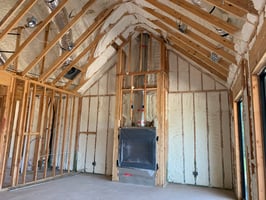If you’re looking for ways to make your home warmer in the winter and cooler in the summer, you may...
How To Install Spray Foam Yourself: A Nightmare for Homeowners
Spray foam insulation is an excellent way to keep your home warm in the winter and cool in the summer. It's known for its effectiveness in energy conservation, but when it comes to installing it, there's a lot you should consider. While the idea of doing it yourself might sound tempting, especially if you're keen on DIY projects, this is one area where professional help is crucial. Here’s why you should steer clear of DIY spray foam insulation and leave it to the pros.
The Complexity of Installing Spray Foam Insulation
Spray foam insulation isn't like painting a wall or fixing a leaky faucet. It involves a complex chemical reaction that occurs when two compounds are mixed together under precise conditions. This reaction creates a foam that expands and hardens to form an insulating barrier. The process needs to be exact, and the timing of the application is critical to ensure the foam expands properly and provides effective insulation.
Cost of DIY vs. Professional Installation
One of the biggest misconceptions about DIY spray foam installation is that it saves money. Initially, it might seem cheaper to buy the materials and do it yourself. However, the equipment and materials for spray foam can be expensive. Professional installers buy their supplies in bulk and often get better pricing than a DIYer can. Plus, if you make a mistake, the cost to fix it can often outweigh what you would have paid a professional in the first place.
Equipment and Material Costs
- DIY Kits: These can range from $2,000 to $4,000 for just the basic setup.
- Professional Installation: Costs can vary, but typically, it's about $2,500 to $6,000 for an average-sized home. This includes the expertise, labor, and guarantee that the job is done right.
Reliability of Installation
Professional installers bring years of experience and training to a project. They understand how to handle the materials and have the expertise needed to ensure that the foam is applied evenly and achieves the correct thickness and coverage. Incorrect application can lead to gaps or too much expansion, which not only affects the insulation’s effectiveness but can also damage your home’s structure.
Warranty and Support Issues
Most DIY spray foam kits come with no warranties. If something goes wrong, you're on your own. In contrast, our installations often come with manufacturer's warranties on materials and our guarantee that it's done right, offering peace of mind that any problems related to the installation will be addressed without additional costs.
Chemical Safety Concerns
Spray foam chemicals can be hazardous. They need to be mixed precisely and applied in a well-ventilated area while wearing proper protective gear. Mismanagement of these chemicals can lead to poor insulation quality and even health risks from fumes or contact with the skin.
Moisture and Ventilation Concerns
Proper ventilation is critical when applying spray foam. Without it, the build-up of fumes can be harmful. Moreover, incorrect application can create moisture traps in walls, leading to mold and structural damage over time. Professionals know how to avoid these pitfalls by ensuring that areas are properly ventilated and that the foam does not seal off ventilation spaces unintentionally.
DIY Spray Foam on Resale Value
DIY spray foam insulation can significantly lower your home's resale value. If not professionally applied, the insulation is often uneven and messy, which is easily noticed by home inspectors and can be a major red flag for potential buyers. Furthermore, spray foam is notoriously difficult to remove or repair without causing damage to the surrounding structures, adding potential future costs for new homeowners. These factors can lead to houses with DIY spray foam being discounted by 20-30% on the market. Buyers are wary of the hidden issues and the additional expense and hassle that might be involved in rectifying a poor insulation job. This makes homes with DIY spray foam less attractive and often results in a lower selling price. Alternatively, a professionally applied spray foam installation is typically a selling point for buyer's which tends to increase resale value.
Lack of Support from Big Box Stores
Big box stores might sell DIY spray foam kits, but they typically offer little to no support when it comes to advice or help with the application. They are not specialized in insulation and cannot provide the detailed support that a professional service can.
What Could Go Wrong?
Here are some real problems that can occur if spray foam is not installed correctly:
- Overexpansion: This can cause your walls to bulge or the foam to spill out of intended areas, creating a mess and potentially damaging your home’s structure.
- Under-expansion: If the foam doesn’t expand enough, it won’t insulate effectively, defeating the purpose of installing it.
- Chemical Imbalance: Incorrect mixing of chemicals can prevent the foam from setting properly, leading to a sticky mess and ineffective insulation.
- Permanent Damage: Once spray foam hardens, it is very difficult to remove without causing damage to the surfaces it covers.
Conclusion
While it's great to tackle home improvement projects on your own, installing spray foam insulation should not be one of them. The risks of incorrect installation, combined with the chemical handling required and the potential for costly errors, make it a job best left to professionals. Not only will hiring a professional save you from a potential disaster, but it also ensures that your home is insulated efficiently and safely. Remember, when it comes to spray foam insulation, it’s always smarter to “don’t” do it yourself.
.png?width=4922&height=4076&name=FINAL%20OFFICIAL%20LOGO%20(1).png)
